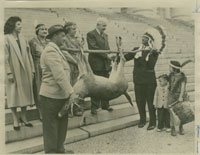We’re Still Here: Virginia’s First Peoples

Virginia’s Indians appeared in the earliest histories of English settlement. Early depictions and descriptions showed the native peoples in settled communities that engaged in agriculture and fishing. Lacking a written history, Virginia’s Indians left no narrative account of their reaction to English settlers. The English, however, used the written word to describe their encounters, successes, and problems during the early days of settlement. The stories about Pocahontas came from European men who understood little of Powhatan culture. By the end of seventeenth century, the native peoples had, for many white Virginians, disappeared.
The annual payment of tribute by Virginia’s Indians attests to their continuing presence. In 1646 Necotowance, “the King of the Indians” as the English styled him, signed a treaty to end the third major Anglo-Indian War. Annual payment of tribute to the colonial governor—20 beaver skins “att the goeing away of Geese”—made clear his submission to the English Crown and made contact between the two groups less spontaneous and more ritualized. Thirty-one years later Cockacoeske, the weroansqua, or chief, of the Pamunkey, signed the Treaty of Middle Plantation, which recognized the authority of the colonial government, but also acknowledged property, land use, and hunting rights of the Indians. More than 300 years later, those treaties continue to shape and govern the relationship between the commonwealth and the eight state-recognized Indian tribes—the Mattaponi, the Pamunkey, the Monacans, the Nansemond, the Chickahominy, the Upper Mattaponi, the Eastern Chickahominy, and the Rappahannock. The Mattaponi and Pamunkey, representing the original treaty signers, also continue to pay tribute to the commonwealth’s government.
By the beginning of the nineteenth century, even the core groups of each of Virginia’s Indian tribes had assumed European modes of dress, speech, and religion; some members had been absorbed into Anglo-American society, some into African American. Some sold their reservation land to white settlers and speculators and stopped paying tribute to the state. On a deeper level, however, they had lost their identity as “Indians,” as far as the majority Anglo-American population was concerned. By the 1840s only the Pamunkey and Mattaponi continued to hold their reservations and maintain the treaty obligations and relationship. The most contentious issue has always been the Indians’ tax-exempt status. Officials like Walter A. Plecker, the State Registrar of Vital Statistics early in the twentieth century, manipulated and distorted records to show that the genealogical heritage of Virginia’s Indians was so intermixed with Virginia’s African Americans that no “real” Indians existed. In addition to his racial purity campaign, Plecker also believed that the reservation tribes no longer deserved their tax exemptions on their land.
Through tribute ceremonies the tribes educated Virginia’s governors about the rights and obligations of the Treaty of Middle Plantation and asserted their sovereign status. The relevant historical documents held by the Library of Virginia, the repository for Virginia‘s government documents, provided the written evidence even as public memory failed. Over the years the tribute presentation has been shifted to the autumn, when deer are most plentiful, and evolved into a ceremony that draws crowds of onlookers to the Capitol in Richmond each Thanksgiving. Although the Pamunkey and Mattaponi continue to pay tribute, all eight of Virginia’s state-recognized tribes honor and attend the ceremony as a reminder of their past power, tenacious survival, and the continued cooperation first articulated in the long-lived Treaty of Middle Plantation.